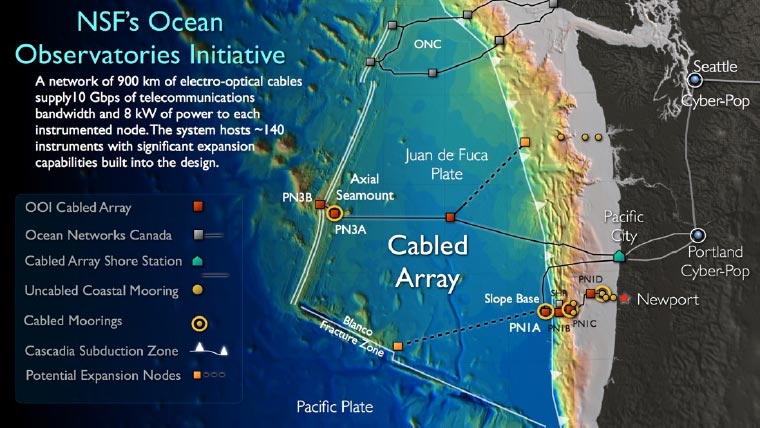Axial Seamount is probably the best-monitored submarine volcano in the world. It is an ideal place to study how volcanoes work because it (1) erupts frequently, (2) has a network of advanced monitoring instruments linked to the shore via a cable so data can be transmitted to the shore in real- or near real-time, and (3) appears to have repetitive behavior from one eruption to the next.
The monitoring of this seafloor volcano is part of an ambitious long-term effort called the Ocean Observatories Initiative (OOI), which is supported by the U.S. National Science Foundation, to collect data for researchers to study generally inaccessible parts of the ocean and seafloor and how they change over the long term. Unlike on land, the seafloor and things that happen under the sea cannot be easily detected or monitored by satellite. Direct measurements and observations in this environment must be made in-situ if processes are to be understood. Axial Seamount was selected as a site to study volcano eruption behavior because, unlike volcanoes on land, the ocean crust through which magma (i.e. molten rock) travels to a volcano’s magma reservoir is relatively thin and homogeneous in composition. Therefore, the physical processes of magma supply, storage, and eruption in seafloor volcanoes are simplified compared with those of their subaerial cousins. This allows scientists to better understand processes and mechanisms that take place before and during volcanic eruptions todevelop models and test hypotheses of volcano behavior.
The OOI cabled observatory at Axial Seamount is helping us better understand how magma is stored in the shallow crust, how it is delivered to the surface, how eruptions are triggered, and whether eruptions can be successfully forecast. At Axial, scientists are using precise pressure sensors and autonomous underwater vehicles to measure vertical movements of the seafloor during the phase when magma rises from the mantle and fills the Axial magma reservoir. This processgradually inflates the volcanic edifice like a balloon. During the inflation and deflation cycles, with deflation occuring during the eruption of lava onto the seafloor, the surface of the volcano caldera moves up and down as much as ~2.5-3.5 meters (8-11 ft).

Monitoring of Axial for almost two decades has shown that this seamount (i.e., undersea volcano) inflates about the same amount before each eruption. This allowed the 2015 eruption to be successfully forecast months in advance. Research on Axial has broad implications for understanding volcano hazards, regardless of the location of a volcano. This monitoring effort is a joint project between the U.S. National Science Foundation, Oregon State University, the University of North Carolina at Wilmington, the University of Washington, the Monterey Bay Aquarium Research Institute and the National Oceanic and Atmospheric Administration’s Pacific Marine Environmental Laboratory.